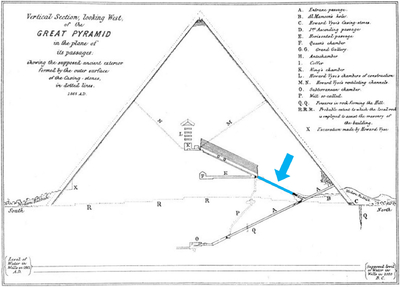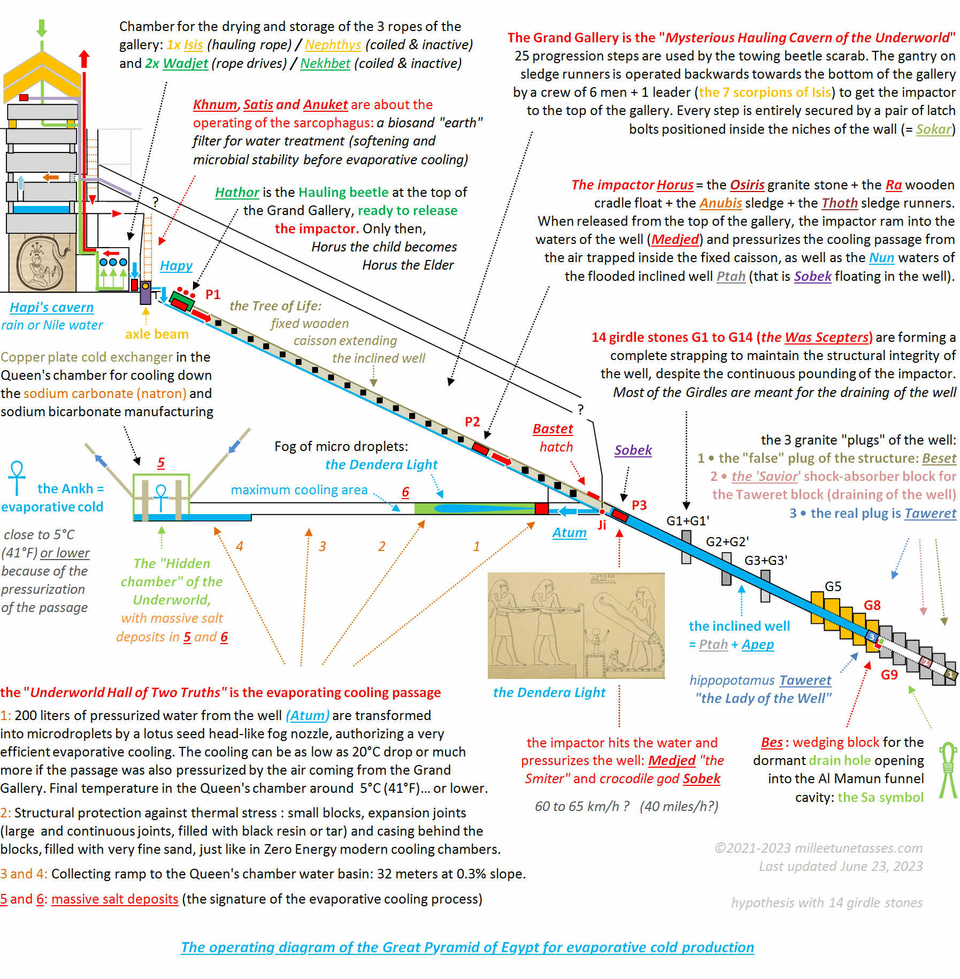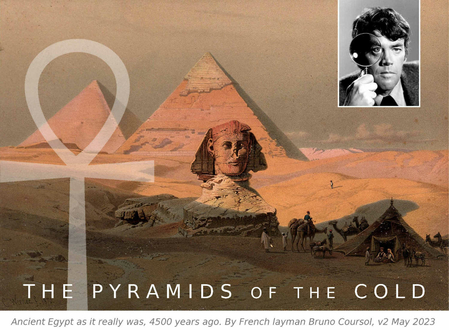- Retour accueil
- Vous êtes ici : Blog The Pyramids of the Cold v2 The Pyramids of the Cold Section 11 • The Was scepter and the control over snakes metaphor
The Pyramids of the Cold Section 11 • The Was scepter and the control over snakes metaphor
Publié par Bruno Coursol dans The Pyramids of the Cold v2 le 13/05/2023 à 19:22

Hatshepsut’s birth scene, from Édouard Naville "The Temple of Deir el Bahari" (London, 1896), vol. 2, pl. 50. Image courtesy of the University Library Heidelberg : The Ebony shrine, northern half of the middle platform. https://digi.ub.uni-heidelberg.de/diglit/naville1896bd2/0050
The Pyramids of the Cold v2 (May 2023) • Part B: the inclined well of the Great Pyramid
Section 11 • The Was Scepter and the "control over snakes", the Sa Symbol and the Tyet Isis Knot

In summary: the Sa symbol is a representation of the opened drain hole of the Great Pyramid inclined well, while the Tyet knot of Isis represents the drain hole locked and closed. Was scepters are representations of the girdle stones of the inclined well of the Great Pyramid of Giza, they represent dominion and power over snakes… and water (snakes = water).

The girdle stones layout of the inclined well of the Great Pyramid of Giza. Photograph from tomb KV 11 of Ramesses III, side chamber, image # 21076 by Matjaz Kacicnik, courtesy of ARCE, American Research Center in Egypt in partnership with the American University in Cairo Egyptology Department: https://thebanmappingproject.com/images/21076jpg
During the entire operating period of the pyramid, the bottom of the inclined well was sealed by the Taweret blog : the upper granite plug. Taweret was maintained in position by a wedging block presenting an easy to break protruding part, getting out of the floor of the well. The breaking of that fragile part released the Taweret block and the waters of the well were drained through the dormant breach, between the Girdle Stones G8 and G9.

Magical stele (detail), Egyptian, Late Period, 26th–31st dynasty, c. 664–332 BCE. Limestone. Harvard Art Museums/Arthur M. Sackler Museum, Bequest of Gerhardt Liebmann: harvardartmuseums.org/article/a-salve-for-your-snake-bites
11.01 Taweret is protecting the drain hole but she is also ready to open it
Taweret is often represented with the Sa symbol pressed onto her belly, like on the above image of a magical stele : it shows that Taweret is protecting the Sa symbol. But here, she also has a knife in her hand: she is also the one who can destroy it.
Taweret is both protecting and ready to destroy the Sa symbol.

11.02 The Sa symbol is the drain hole of the well: "the loop of the Sa symbol was believed to give birth to water"
The fact that Bes and Taweret are the only deities associated with the Sa symbol could only mean that this symbol is a representation of the breach itself.
On the above first images of Taweret, we can see that the Sa symbol is hiding a "pouring hole" that is strongly suggesting the draining of the water. On the last image of Taweret, she is depicted giving birth to a snake, meaning: to water.
Also, it is known that "the loop of the Sa symbol was believed to represents the mouth of a fish giving birth to water". Source: https://www.landofpyramids.org/sa-symbol.htm

Was Scepters are the representation of the girdle stones of the Great Pyramid of Giza inclined well. Draw of a relief on the North wall of the Gate of Hadrian with a representation of the Nile god Hapi, crouched in his cave and surrounded by a serpent, Isis temple at Philae, Egypt: https://fr.wikipedia.org/wiki/Fichier:Hapy_Philae.JPG
How to Catch a Snake: https://www.wikihow.com/Catch-a-Snake
11.03 Dominion over water: the Was Scepters are representations of the Girdle Stones
The Hatshepsut’s birth scene relief turns out to be a real gold mine, because not only we can validate the Bes and Taweret interpretation, as well as the understanding of the Sa symbol, but we can also decipher another symbol from this relief: the Was Scepter.
On the left side of the Bes and Taweret scene, we can see the Sa symbol flanked by 2 Was Scepters. These scepters are not randomly positioned: they are both turning their faces towards the Sa symbol. They are flanking the Sa symbol and looking right to it like it was their baby. Don't you think the Was Scepters have a very touching/loving/amusing kind of look, facing the Sa symbol?
Well, I do, and I also think that somehow, the Sa symbol really is their little baby !
We've just seen that the Sa symbol was a representation of the drain hole of the well, and we also know that this drain hole was set in between 2 particular girdle stones: G8 and G9 (more information on that matter, on previous posts).
What it means is that the Was Scepters are representations of the girdle stones.
And it makes perfect sense. We know that snakes were representations of the water used to power up the Great Pyramid, so what better way of representing the control over that water, than by the control over snakes.
If Was Scepters are very much looking exactly like snake handling tongs, it is because they really are snake tongs. Except of course these snake tongs are actually metaphors.
Ancient Egyptians didn't want to talk about the control they had over snakes, but over the "magical" pressurized water of the well : they wanted to talk about the containment of the waters of the well.
This idea of having power over snakes that would be associated with the Was Scepter, is exactly what is saying the second above image. Both hands are doing the same thing: the firm grip on snakes (control over snakes) on one hand is equal to the Was Scepter hold in the other hand.
Also, from Wikipedia's page on the Was Scepter: "Was sceptres were used as symbols of power or dominion, and were associated with ancient Egyptian deities such as Set or Anubis as well as with the pharaoh. Was sceptres also represent the Set animal. In later use, it was a symbol of control over the force of chaos that Set represented." Source: https://en.wikipedia.org/wiki/Was-sceptre
This "force of chaos" is the pressurized water of the well.

Was Scepter from Djoser's Step Pyramid, constraining water and redirecting some of it.
Was Scepter from Djoser's Step Pyramid, now at the Imhotep Museum, part of a doorway with blue faïence tiles from beneath the Step Pyramid, thanks to kairoinfo4u: https://www.flickr.com/photos/manna4u/5260508828/
11.04 The containment of the pressurized waters of the well and the sequential ejection
The idea that Was Scepters are representations of the girdle stones of the Great Pyramid and metaphors of the containment of the waters of the inclined well, is exactly what is suggested by the above images from Djoser's Step Pyramid where a Was Scepter is "holding tight" something in his hands. That something, with no particular shape, is water.
Djoser's Was Scepter is constraining that water with one arm, and at the same time he is redirecting some of it with the other arm. The weird "scorpion" shape element with its 2 cuffed arms is representing the small amount of pressurized water getting out of the well towards the horizontal cooling passage.
Also, we've already seen that the Step Pyramid was involved in a cooling process : "Of course, Imhotep is most famous as the builder of Djoser's unprecedented step pyramid complex, called the "The Refreshment of the Gods.” Source: https://www.arce.org/resource/search-imhotep-tomb-architect-turned-god-remains-mystery
Again, the idea that the Was Scepter is a metaphor for some liquid in motion is already known:
"De Lubicz via Paul LaViolette speaks of the was as "a living branch that conducts nourishing, vivifying sap, fluid that ascends..." and even found some was scepters "made from the living branch of a tree that had been cut so as to include a section of the lower source branch as well as two offshoots coming from its upper end". (Genesis of the Cosmos, page 30)". Source: http://www.joanlansberry.com/setfind/earlywas.html

The Tyet Isis knot is a representation of the drain hole of the Great Pyramid inclined well, in its closed position.
Isis-knot Amulet https://www.brooklynmuseum.org/opencollection/objects/4131 and Tyt-Amulet from the Brooklyn Museum: https://www.brooklynmuseum.org/opencollection/objects/3994
11.05 The Tyet "girdle of Isis" knot is the drain hole in its closed and locked position
The interpretation of the Sa symbol being the drain hole is actually incomplete : because it is known that the loop was "giving birth to water", it would be more appropriate to consider the Sa symbol as the drain hole in its opened position, as are suggesting its opened legs.
It would mean that ancient Egyptians had most probably also represented the drain hole in its closed position, when the girdle stones would have completely sealed the hole.
And that is precisely what they did: the Tyet Isis knot is the drain hole in a closed position.
The above Tyet amulet from the Brooklyn Museum, is even showing the girdle stone representation itself: that is the inverted U shaped element that we've already seen in the relief of Apep being restrained by these same girdles.
We don't have to be fooled by the fact that on the Apep relief, the legs of the girdles aren't the same length: this is only the result of the perspective that used the artist to represent kind of a 3D effect.
Also: "The tyet (Ancient Egyptian: tjt), sometimes called the knot of Isis or girdle of Isis, is an ancient Egyptian symbol that came to be connected with the goddess Isis." https://en.wikipedia.org/wiki/Tyet

The restraining of Apep in the above relief from Ramesses KV19 tomb, is another representation of the containment of the pressurized water generated in the inclined well. Once pressurized and contained into the well, a small amount of the "powered" waters can be redirected towards the evaporative cooling passage.

Diagram of the operating Great Pyramid of Egypt for evaporative cold production (hypothetically for chemical manufacturing cooling of pure sodium carbonate "natron", the salt used for the mummification of pharaohs). When in operation, the elevation of the Great Pyramid was not finished, and it is only after the shutdown procedure and the draining of the inclined well, that the 3 granite plugs were finally close to one another.

The Pyramids of the Cold version 2 (May 2023 - May 2024)
Summary of the study and Table of Contents
Part A: The evaporative cooling process
Section 1 • The horizontal evaporative cooling passage layout
Section 2 • The Dendera Light and the creation of the fog of microdroplets by the fog nozzle
Section 3 • The water cycle glorifying metaphors: Geb, Shu, Nut, Tefnut
Section 4 • The theorization of the evaporative cooling process by Akhenaten and Nefertiti
Section 5 • The theorization of the evaporative cooling process in the Weighing of the Heart
Part B • The inclined well of the Great Pyramid of Giza
Section 6 • The inclined well layout and the girdle stones
Section 7 • The Taweret "Lady of the Well" temporary sealing granite plug of the well
Section 8 • The Bes temporary wedging block immobilizing Taweret
Section 9 • The draining of the well
Section 10 • The Great Serpent Apep and the snake water metaphors
Section 11 • The Was scepter and the control over "snakes"
Section 12 • The beating Heart of the Great Pyramid
Part C • The composite impactor of the Great Pyramid (Horus, Ra, Osiris, Medjed, Sobek...)
Section 13 • The wooden and stone composite design of the impactor: Ra and Osiris
Section 14 • The endlessly immersed Osiris stone and the seed metaphor
Section 15 • The Anubis sledge and the bobsled mask
Section 16 • The sledge runners of the impactor: Thoth
Section 17 • Medjed: the smiter nobody can ever see
Section 18 • The Apis bull and the ramming impactor's metaphors
Section 19 • The crocodile god Sobek impactor (more or less) floating in the waters of the well
Section 20 • The Obelisk and the Benben stone rising from water
Part D • The Grand Gallery's of the Great Pyramid of Giza
Section 21 • The Sacred "sloping paths" of the "oval-shaped cavern of the act of Hauling"
Section 22 • The central wooden caisson of the Gallery: Sekhmet and the Triad of Memphis
Section 23 • The hauling ropes of the Grand Gallery: Isis, Nephthys, Hatmehit, Wadjet and Nekhbet
Section 24 • The hauling Beetle and the Seven Scorpions of Isis
Section 25 • The Great Cow goddess Hathor and the operating cycle of the hauling Beetle
Section 26 • The 10 operating phases of the Grand Gallery
Section 27 • The guide to the Afterlife for the smart traveler and the canopic jars
Section 28 • The scarab amulet glorifications of the hauling Beetle
Part E • The very large and roughly finished sarcophagus of the Great Pyramid
Section 29 • The biosand filter sarcophagus of the Great Pyramid
Section 30 • The Elephantine Triad deification of the biosand filter of the Great Pyramid
Section 31 • The Great Pyramid's operating flat roof and the water supply issue
Part F • Chemical manufacturing and industrial cooling before the Great Pyramid
Section 32 • The Serdab and the "Refreshment of the Gods" Step Pyramid of Djoser
Section 33 • Sneferu's Red Pyramid and the accumulated ammonia
Section 34 • The Disc of Sabu and the Solvay process for pure natron manufacturing
Part G • The tremendous impact of the Great Pyramid on the whole ancient world
Section 35 • The hidden secrets of the Hermetica Emerald Tablet (around 1600 C.E.)
Section 36 • Thor and the magical Hammer in the Great Hall of Bilskirnir
Section 37 • The Churning of the waters of the Ocean of Milk (Hindu mythology)
Section 38 • The Tibetan prayer wheels and the Grand Gallery's operation
Section 39 and Conclusion • The cooling water of spitting Kebechet
Part H • Epilogue
Section 40 • The smiting Ark of the Covenant and the Ten Commandments
Section 41 • The 293 kilograms windlass Staff of Moses and Aaron... and the First Plague of Egypt: water turning into blood
Section 42 • Ezekiel's Four Egyptian pulley "Wheels within the Wheels" and the four angel ropes
Section 43 • David, Saul, two giant Goliaths, five little stones, an aeolian harp... and a weaver's beam
Section 44 • The holy water fonts and the biosand filter
Part I • The magicians of the Great Pyramid of Giza
Section 45 • The Legend of Khufu and the "magician" polymath Imhotep
Section 46 • The two magical eyes of Isis and the brilliant but painful flame of her twin sister's braids
Section 47 • The Aegis Shield of Athena "Subduer of the Winds" and the upper hatch of the central wooden caisson
Section 48 • The Seven Magical Words spoken by 'Divine Sealer' Goddess of Arrows and Bronze Neith
Poster un commentaire
